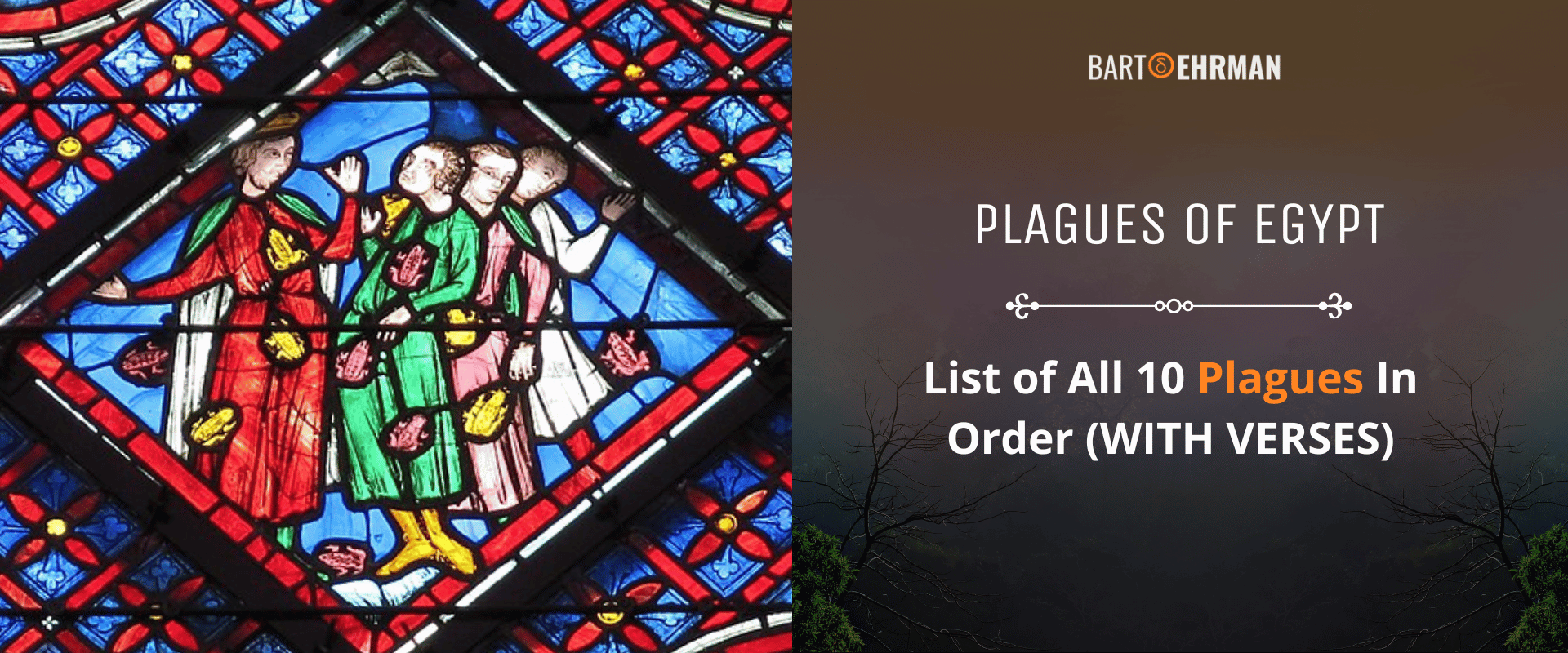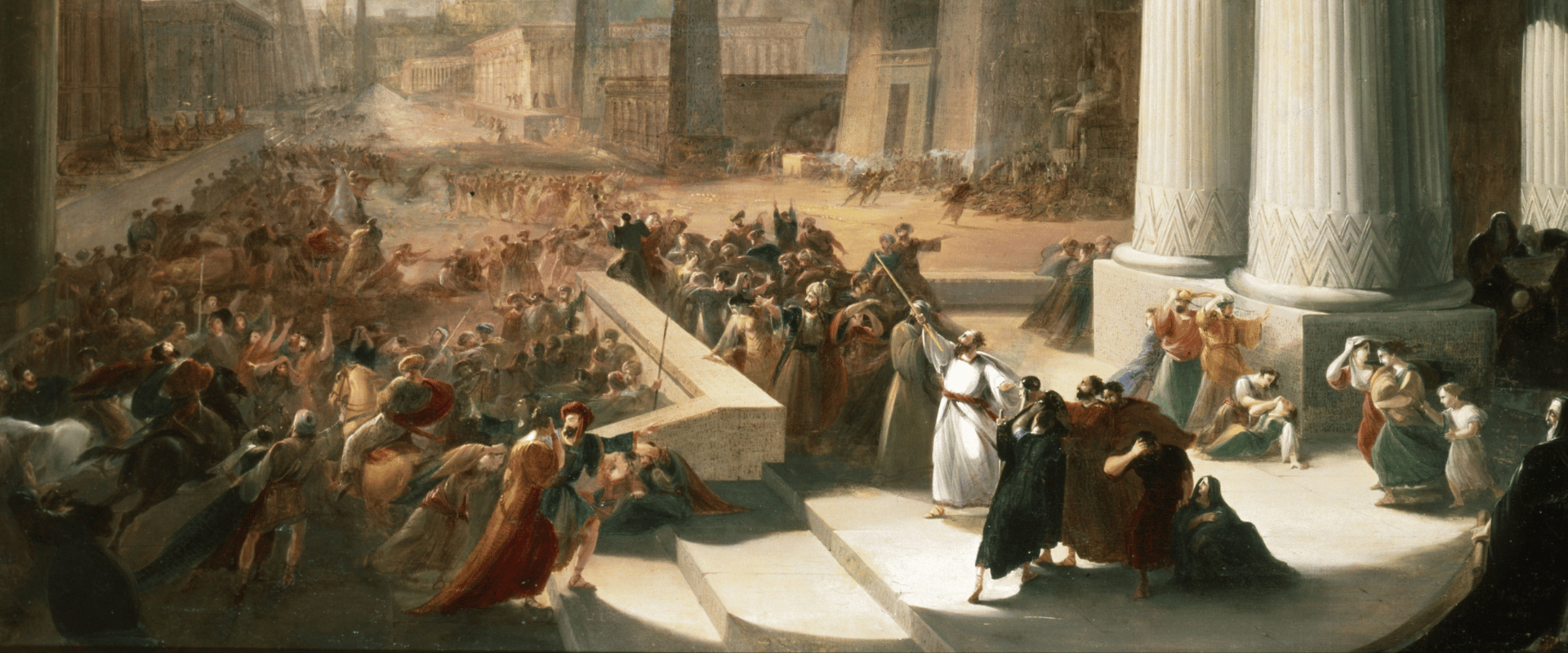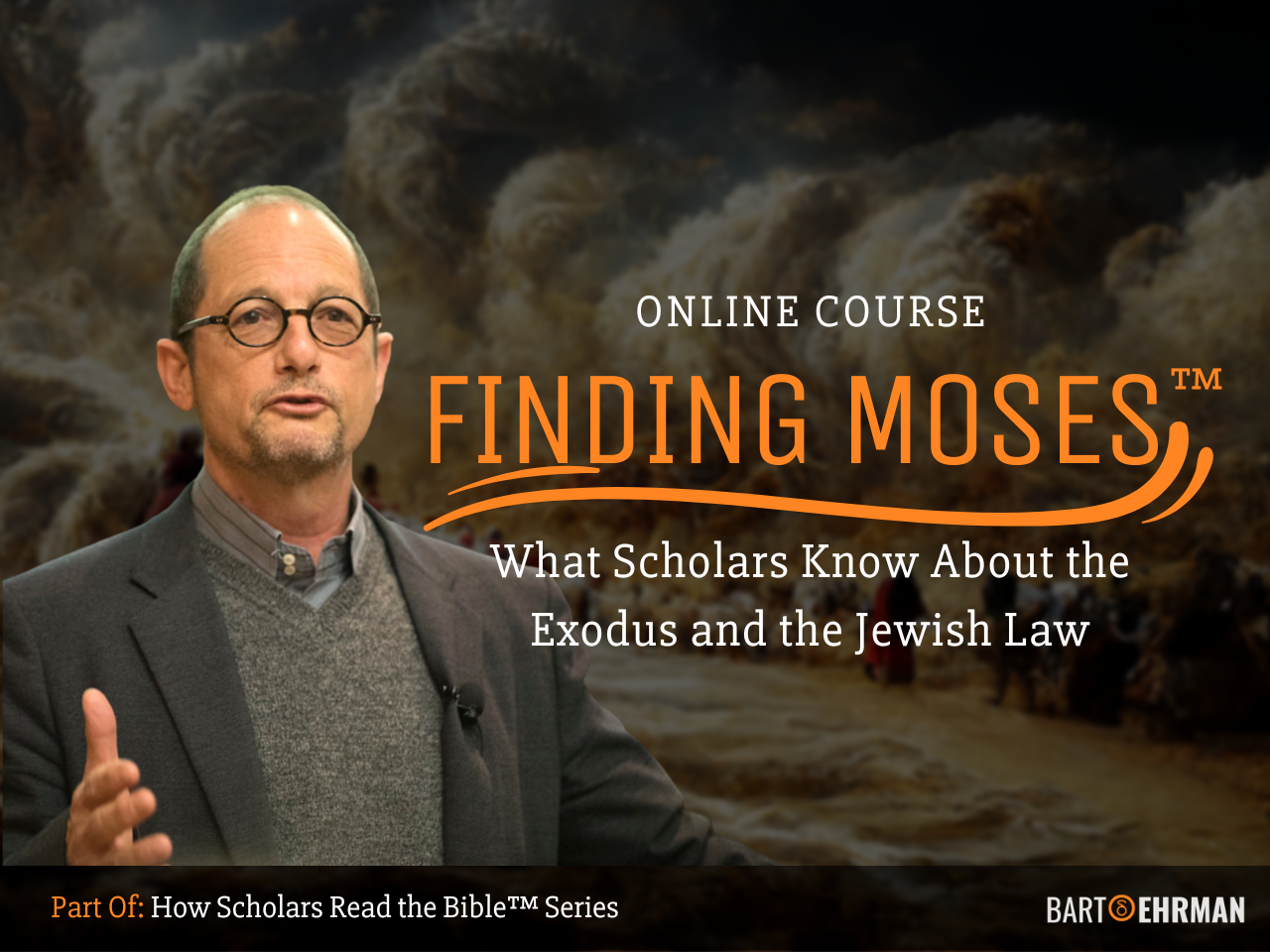Plagues of Egypt: List of All 10 Plagues In Order (WITH VERSES)

Written by Joshua Schachterle, Ph.D
Author | Professor | Scholar
Author | Professor | BE Contributor
Verified! See our editorial guidelines
Verified! See our guidelines
Date written: August 6th, 2024
Disclaimer: The views and opinions expressed in this article belong to the author and do not necessarily match my own. - Dr. Bart D. Ehrman
The story of the Ten Plagues of Egypt, chronicled in the Book of Exodus, is one of the most iconic and dramatic episodes in biblical literature. These cataclysmic events unfold as the God of Israel, through the prophet Moses and his brother Aaron, unleashes a series of divine punishments upon Egypt.
In this article, I’ll first provide a table listing the Ten Plagues of Egypt in order. Then I’ll give a short explanation of each one, culminating in a discussion of whether scholars believe this story is historical.

Summary of the 10 Plagues of Egypt
The Plagues of Egypt are part of the liberation story of the Book of Exodus. The God of Israel sends ten catastrophes upon Egypt to persuade the Pharaoh to liberate the Israelites who have long been enslaved there. The story of the Ten Plagues starts in Exodus 7 and goes through Exodus 12, where God inflicts the last and arguably most devastating plague. One of the implications of this story is that the God of Israel is asserting his power over the Egyptian gods, which is why in Exodus 7:5 he says, "The Egyptians shall know that I am the LORD."
Before we get to a more detailed discussion of the Plagues of Egypt in order, here is a table with some brief information about them:
Number | Description | Verses |
|---|---|---|
First Plague of Egypt | The Nile River is turned to blood | Exodus 7:20-25 |
Second Plague of Egypt | Innumerable frogs plague the land | Exodus 8:1-15 |
Third Plague of Egypt | An outbreak of lice afflicts humans and animals | Exodus 8:16-19 |
Fourth Plague of Egypt | Flies or wild beasts (depending on translation) | Exodus 8:20-32 |
Fifth Plague of Egypt | Disease (pestilence) kills livestock | Exodus 9:1-7 |
Sixth Plague of Egypt | Festering boils on humans and animals | Exodus 9:8-12 |
Seventh Plague of Egypt | Thunder, hail, and lightning | Exodus 9:18-35 |
Eighth Plague of Egypt | Locusts devour crops and cover the land | Exodus 10:3-20 |
Ninth Plague of Egypt | Egypt is enveloped in darkness | Exodus 10:21-29 |
Tenth Plague of Egypt | Egyptian firstborn sons are all killed | Exodus 12:29-32 |
The Plagues of Egypt Explained
What happened during each of these events? Here are the 10 plagues of Egypt explained, including the effects they had on the land and its inhabitants.
1. Nile Turns to Blood
In the first plague, Moses approaches the Nile, along with his brother Aaron. At God’s instruction, Aaron strikes the water with his staff, and it instantly changes to blood. All the fish in the river die and the river emits a noxious smell. No one can drink from the Nile, and all the other bodies of water in Egypt turn to blood as well. Every Egyptian and all the animals of Egypt suffer great thirst for a week as a result.
Despite all this horror, Pharaoh asks his own magicians to do the same trick. They succeed, creating a second layer of blood on the water. Because of this, Pharaoh is not impressed and ignores Moses and Aaron, his heart remaining hardened toward the idea of liberating the Israelites.
2. Frogs
God causes huge numbers of frogs to come out of the no-longer-bloody Nile. There are so many that they cover all the land, even invading people’s houses. Pharaoh’s magicians are once again able to replicate this trick, however, bringing on another wave of frogs. The frogs stay around for three days and then they all die. The Egyptians have to get rid of the dead frogs, whose corpses make the land stink for a long time. However, Pharaoh still doesn’t let the Israelites go free.
3. Lice
God tells Aaron to raise his staff and strike the dust of the ground which instantly turns into lice (some translations say gnats — the Hebrew word could mean either). They cover the land and oppress the people and animals of Egypt. However, Pharaoh still adamantly refuses Moses’ demands.
4. Flies or Wild Beasts
This plague causes either swarms of flies to cover everything or huge numbers of wild beasts to invade every inch of land, including houses and other buildings. It all depends on the translations, but how could they be so different?
This one needs a bit of explanation. The Old Testament Hebrew word used for this plague is ‘arov. According to Gary Rendsburg, the root of this word means “to mix,” making its literal meaning “mixture.” But a mixture of what?
Jewish scholars have debated about this for centuries. In a document written in the 3rd or 4th century CE called the Haggadah — a retelling of the story which is read aloud during the Passover Seder meal — it says there was a plague of wild beasts. This is clear from the many illustrations accompanying Haggadah copies which show lions and other animals. However, The New Jewish Publication Society’s translation of the Hebrew Bible identifies the fourth plague as “swarms of insects.” Which translation is correct? (Affiliate Disclaimer: We may earn commissions on products you purchase through this page at no additional cost to you. Thank you for supporting our site!)
Rendsburg points out that the best answer comes from a scholar and rabbi named Umberto Cassuto. In his commentary on Exodus, Cassuto notes that the plagues come in sets of two. Plagues 1-2 are related to the Nile; plagues 5–6, are both diseases; plagues 7–8, hail and locusts, both come from the sky and destroy the crops; and plagues 9–10 share the feature of darkness. For this reason, Cassuto says that the fourth plague must share something in common with the third plague, lice. Since lice have more in common with flies than wild beasts, Cassuto says the plague should be understood as a “mixture” — ‘arov — or swarm of insects.
By the way, Pharaoh doesn’t change his mind at this point and still refuses to let the Israelites go.
5. Pestilence
This plague afflicts all the livestock with fatal diseases. The beasts of the Israelites, however, remain healthy and untouched. Does this change Pharaoh’s mind? No, his heart remains hardened.
6. Boils
God tells Aaron to take handfuls of soot and throw them into the air in front of Pharaoh. The soot multiplies into dust, covering everything and everyone and causing boils on the skin of both humans and animals throughout Egypt. Pharaoh, of course, remains unmoved.
7. Thunder, Hail, and Lightning
Moses lifts his staff to the sky and God sends a massive storm of thunder, hail, and lightning, leaving Egypt in ruins. Anything out in the fields, including people, animals, plants, and even trees, is destroyed.
This time, Pharaoh summons Moses and begs him to stop the storm, swearing that he will let the Israelites go. Moses readily agrees, but once the storm ceases, Pharaoh changes his mind and goes back to his hard-hearted ways.
8. Locusts
Now God sends a massive swarm of locusts to cover the land, devouring what few crops remain after the hailstorm. The locusts also fill houses and every other building. Pharaoh once again begs for it to stop and swears to Moses he’ll let the people go. But as soon as the plague ends, he again refuses to free the Israelites.
9. Darkness for Three Days
Moses stretches his hand to the sky at God’s insistence and the entire land is instantly covered in darkness for three days. Exodus says the darkness was so complete that no one could see anything or leave their houses for fear of hurting themselves in the dark.
Pharaoh still doesn’t change his mind, but he does become furious, telling Moses that while he won’t let his people go, he never wants to see Moses again. Moses agrees to this.
10. Death of the Firstborn Sons
The tenth plague is God’s final, devastating blow against Egypt. The Israelites are told that the Angel of Death will come to each house in Egypt that night. Through Moses, God tells the Israelites to slaughter a lamb and paint their doorframes with the lamb’s blood so that the Angel will “pass over” that house and not kill anyone inside. They are also to eat only unleavened bread for seven days. This of course, is the story of Passover.
At midnight, God sends the Angel of Death who kills all firstborn sons in the land of Egypt. No Egyptian family escapes this fate, from the Pharaoh himself, down to the lowliest members of Egyptian society. The angel even kills all the firstborn males among the livestock. Exodus says anguished wails fill the night air.
Finally beaten, Pharaoh summons Moses and Aaron and says, "Arise, go out from among my people, both you and the children of Israel; and go, serve the Lord as you have said.” Having endured an enormous amount of misery at the hands of Israel’s God, Pharaoh finally agrees to liberate the people of Israel.

Historical Criticism of the 10 Plagues
What do historians say about Moses’ plagues caused by God? Moses’ story begins in Exodus. However, in Biblical History and Israel’s Past, Megan Moore and Brad Kelle note that the book of Exodus is not a historical account. Scholars know the Israelites actually emerged as a subset of the Canaanite people. While a small number may have lived in Egypt at one time, there was never a massive Exodus. This underlying fact makes the historicity of the Ten Plagues of Egypt highly doubtful as well.
In the Jewish Study Bible, Jeffrey Tigay notes that while there have been many attempts to explain the plagues as natural phenomena, the vast majority of biblical scholars have dismissed these explanations. The timing of the plagues, their quick progression, and the fact that Moses controls them indicates that they are supernatural. While something supernatural may have happened, it is far beyond the scope of historical analysis to confirm or deny this.
Some have claimed that the Passover festival, which celebrates how God allowed the firstborn sons of Israel to live while those of Egypt all died, is evidence that the tenth plague must have actually happened. However, in Deuteronomy and the Hermeneutics of Legal Innovation, Bernard Levinson shows that the practice of painting blood on the doorframe of a house actually may have originated earlier than Exodus as an apotropaic rite, that is, a ritual to ward off evil, meant to prevent demonic forces from entering a house.
A further theory. written by Tamara Prosic in The Development and Symbolism of Passover, is that once the Israelites wrote the Priestly Code — rules and regulations for Jewish priests —, the apotropaic rite of painting the doorframe became mixed with a Canaanite agricultural festival involving a ceremony of unleavened bread. In other words, while there is no absolute certainty about Passover’s origins, it doesn’t necessarily require a supernatural explanation.
Conclusion
While scholars have determined that the story of the Plagues of Egypt is not historical, it has long provided Jews and Christians with a level of meaning superseding factual history. For one thing, the narrative contributed to the formation of Jewish identity as related to their God. It showed, for example, that the Israelites were so important to God that he would harm other nations if necessary to protect Israel.
Despite the fact that historians will never be able to confirm these supernatural events, the story of the 10 Plagues of Egypt is a literary achievement, showing us how the author of Exodus viewed his people’s place in the world. While not yet monotheistic (he did, after all, believe that Egypt’s gods existed), this author clearly believed that the God of Israel was the superior being.
Scholars say Exodus was written after the Israelites’ Babylonian and Persian exiles. It was, therefore, an attempt to solidify Israelite identity, based both on earlier stories and literary inventions. These stories argued that no matter what difficulties they faced, the people of Israel would always be cared for by their God.

